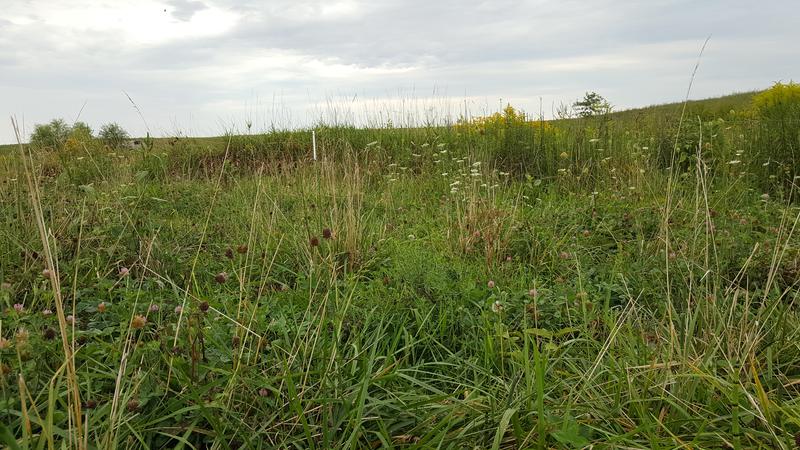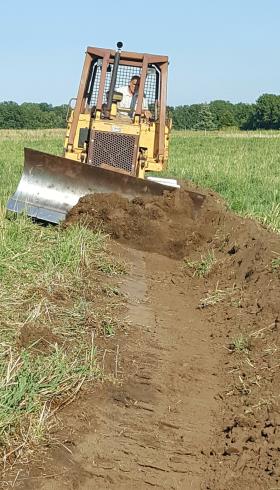Our farm (the soil, water, grass, trees, etc.) is our most valuable resource. We manage it in a way that takes care of the resources, the animals, wildlife, and our health. One of the most important ways that we take care of the farm is through conservation and we work to regenerate the soil for healthier plants and animals. We have fenced our cattle out of the creeks to help improve water quality and erosion. We believe that doing this provides better water quality for our animals, nature, and everyone down stream from us. We also have 20 acres that we have taken out of production to plant berries, nuts, fruit trees, hardwood trees, and conifers. These areas provide wind breaks for the cattle in the winter and provide shelter and food for wild animals which is much needed to keep a healthy environment.
One of our latest developments is creating a swale. A swale is created so that surface water that runs off from one area moves to other areas that the water can be utilized. This swale helps to reduse soil erosion and improve water usage. The swale diverts surface water that runs off of our barn and house area that would usually run directly to the creek. This water erodes gullys and increases high water levels in the creek during rain events. We are diverting this water to the pasture where we can utilize the water by our perennial grasses and nuts, berries, and trees. Physically creating the swale involves using a bulldozer to dig a trench that will direct the water to where it can be utilized.
None of our beef, chickens or turkeys are given any steroids, hormones (growth or otherwise), or antibiotics. They are not altered chemically in any way and no preservatives or artificial ingredients are added to any of the products grown on our farm.
We treat our animals humanely and continue to develop and integrate our facilities to work our animals in the best and safest way possible.
Why is knowing where your food comes from important?
The importance of knowing where your food comes from starts from the ground up. If you're not taking care of the soil, the soil can't take care of the plants and in turn the plants are not healthy feed for the animals that we ingest. On our farm we are actively involved with the following programs to ensure the highest soil quality:
 --Iowa State University
--Iowa State University
 --Drake University
--Drake University
 --Chichaqua Conservation
--Chichaqua Conservation
 --Practical Farmers of Iowa
--Practical Farmers of Iowa
 --Iowa Forage and Grassland Council
--Iowa Forage and Grassland Council
 --Steering Commitee for Grassbased Working Group
--Steering Commitee for Grassbased Working Group
 --Iowa Cattlemans Association
--Iowa Cattlemans Association
 --Polk County Cattlemans Association
--Polk County Cattlemans Association
 --Iowater, Volunteer Water Quality Monitoring
--Iowater, Volunteer Water Quality Monitoring
 --Iowa Farm Bureau
--Iowa Farm Bureau
 --NRCS
--NRCS
 --EQUIP
--EQUIP
- --EQUIP Sub Committee
Grass-fed beef vs. corn/pasture-fed beef?
The choice between grass-fed and corn-fed is really one of personal choice. There are health benefits to eating grass-fed beef over corn-fed, however, many believe there are flavor benefits to corn-fed beef. Both of our beef options are all-natural. Grass-fed beef tends to be lower in fat and calories and is found to have a higher content of Omega-3 fatty acids, which is good for the heart. Grass-fed beef is also higher in vitamins and is a good source of Conjugated Linoleic Acid, which is another good fat for the body.
Our family raises both, eats both, and sells both!!! You can make the choice for your family.
Carney Family Farms
 | ||||||
What we believe:
Bruce and Grace Baumgartner bird counting
**Please pardon our mess - we are updating our website!***
Bruce using a bulldozer to create the swale
Pasture mix that grows over 8 feet tall. Just one of the ways that we are building soil through growing plants and deep roots.
Bird Monitoring Research
text.https://practicalfarmers.org/wp-content/uploads/2018/10/17.L.Monitoring-Birds-in-Rotationally-Grazed-Pasture_2017-Update-ilovepdf-compressed.pdf
Meat Quality Omega 6 Omega 3 Ratios
text.https://practicalfarmers.org/research/carcass-characteristics-meat-quality-and-fatty-acid-composition-of-100-grass-fed-beef/
Soil Health Research
https://practicalfarmers.org/wp-content/uploads/2019/08/18.L.CC.Compaction-in-Grazed-Cover-Crop-Fields.pdf

